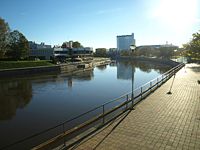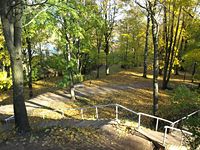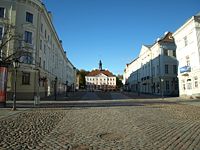Pictures of our Landscapes Tartu Group 2
Jump to navigation
Jump to search
---> Back to overview of groups
Authors: Annika Nurmi, Madara Mediņa and Baiba France
Images
Description
The three most characteristic parts of Tartu city for us as foreigners are the Emajogi River, the old town and the city parks. We can read from them how the city has developed, how the cityscape has formed and which elements are the most describing. The Emajõgi River is very important element for Tartu city. It has shaped the terrain during thousands of years since last glacial period. The river banks, the flood plains and the meanders have impacted the city layout like directions of the streets, placement of the houses, bridges etc. The river has also attracted people of all ages for many centuries and in all seasons. This fact plays the main role for riverbank design - promenades both side of the river, green belts of grass and trees, parks, places for sitting, bridges for pedestrians and traffic, buildings for residential and business use. The riverbank of Emajogi River is constantly changing with the seasons, because of water level and vegetation changes and also, because a great number of people using it. The river and the city parks give Tartu a balance between natural and artificial structures. Tartu's central park, called Toome Hill, is the biggest park and has a variable ground relief. It was the centre of the medieval Tartu bishopric with its impressive cathedral. Today, many of the medieval building elements are an important part of the park's landscape. There are fragments of medieval fortress granite ruins, red brick walls of church, many paths and stairs from different ages and made out of several materials. The park is under the historical protection and therefore it has not changed significantly. Size of the trees can tell about age of the park. There is a beautiful view to the city from the hill top. Vegetation and the four seasons influence to the landscape of the city. The landscape is mainly dominated by perennial trees like lime tree, maple and oak with variable shrubs and flowers. Spring is the time of blooming and the city becomes very colourful after the winter season. In summer dominant colour is green, but in autumn trees change the colour of the leaves to yellow and red and then finally drop them out. It gives the city a dynamics and makes it attractive through the year. The old town tells a lot about the city's development, age and style. The Town Hall square is the heart of the city, it is located close to the river and it is only for pedestrians such as a large part of the old town. The buildings are mostly 2 or 3 floors high and they have stylistically different building elements and shades, which means that they have been built at different times and probably renovated several times. On the first floors are mainly cafes, restaurants and souvenir shops. In summer time big part of the square is occupied by outdoor cafes and they are usually overcrowded. The pavement material is granite like it was some centuries ago. The old town is a part of a city which does not follow the changes so rapidly.


